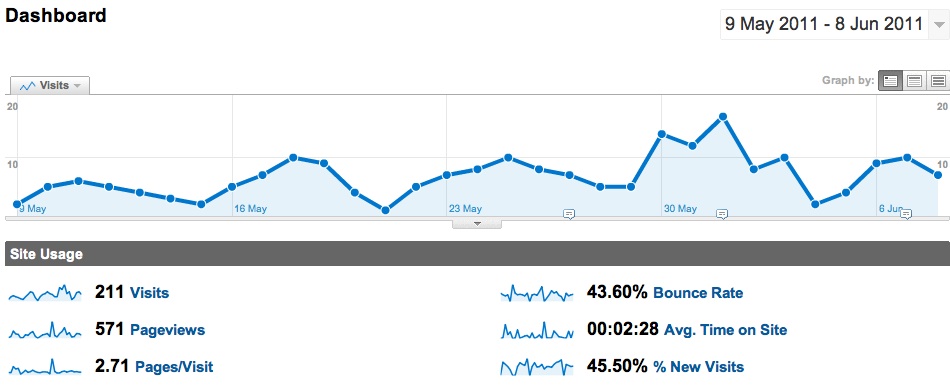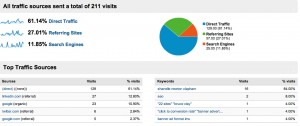Before web analytics there was adserving media tracking called spotlight tags or action tags or post click and post view tracking and at the time these were brilliant and revolutionary. Post click and post view conversion tracking tags (tags are the html code that the adserver provides you with to add to your website conversion page so that the goal, action or conversion can be allocated to your paid media) still exist and are still excellent forms of tracking your paid digital media campaigns, down to individual banner creative or email and publisher or site level.
Before a digital marketer was reliant on this adserving media tracking for data. Not any more. With website analytics you can now track all of your campaigns – whether they be paid media or internal communications to your existing users, customers, clients or supporters. Web analytics provides a deeper level of data about how your, let’s call them users from here on in, come to your site and how they behave once they are within your site – the actions they take, the pages they view, the path they use to navigate around and the pages they enter and exit on. Of course that’s not all but it gives you a quick snapshot of how detailed it can get.
It’s important to say here that website analytics does not track an individual to the point of collecting their individual personal details. Your website might capture data about your customers, but the analytics software does not. It does track individuals from a data point of view but only as an IP address to acknowledge them as a unique visitor or browser (UV and UB depending what language you use) or a repeat visitor.
From this screenshot you can see the type of snapshot data you get about your users from your Google Analytics dashboard.

Web Analytics are known as “site centric“. This means that they only tell you about YOUR website, not about your competitors. You need to use other online audience intelligence tools for this information, such as Nielsen Online or Hitwise Market Intelligence.
Your Google Analytics account is set up by adding a peice of html code to the body of every page on your website. From here the analytics software is able to tell you about your own website and its visitors behaviour.
For those unfamiliar, the visits are total visits within the timeframe you have selected (default is last 30 days), not unique. you need to go deeper into Google Analytics for the unique breakdown.
Page views are the number of web pages viewed by your total visitors for the time frame. Pages/ Visit is the average page view per user.
The bounce rate represents the percentage of users who have left your page after only looking at one page (usually means they hit the back button and went no further). You want to aim to keep your bounce rate as low as possible. The fewer people that bounce off your site means that they found what they were looking for, which is your ultimate aim.
Ave. Time on Site is the aggregate of all your visitors and the average time is also an indicator of how useful your site is. A general rule of thumb is that the longer people spend on your site, the better. You might find a job board or a newspaper website can hold a user’s attention for up to 10 minutes but in my experience, with retail and information based website, most ave. time spent is closer to the 2-3 minute mark.
The % of new visits indicates how popular or sticky your website is. If you have a high percentage of repeat visitors this means you are building a loyal audience. You want to aim for a 50/50 or 60/40 split of new traffic and repeat visitors so that your audience is always growing but of course you don’t want to lose your existing readers.
Website analytics can also tell you where you visitors have come from – as in, did they click on a Google or Yahoo or Bing search result listing or did they come to you from a link on another website (called a referral site). Often your direct traffic is an indicator of the number of users who have bookmarked your website or are familiar with your site and type the URL directly into the browser address bar.
 How you read this information depends on your assumed or actual knowledge.
How you read this information depends on your assumed or actual knowledge.
Direct traffic shows the percentage of your audience that is loyal and is already familiar with your brand or website.
Referral traffic can show the strength of your brand or information that other sites want to link to you but in the case of my website you can see that it is largely LinkedIn and Twitter which is the medium I use to promote my blogs and therefore this data is skewed as I am actively referring people through my own networks. Were these other blogger sites or industry websites that valued my point of view and pushed their users to me for more information, I would be ecstatic and this is the ultimate goal. To have a large group of websites that link to your content because they value it and believe it will be useful to their readers.
Search engine traffic is the final piece of the pie. It takes time to build up your search engine optimisation strategy and linking and eventually your Google and Yahoo page rankings will improve if users are finding relevant information to their keyword search. Search engine traffic is your biggest opportunity to drive people to your website. You might have a great brand and be able to get a lot of traffic directly but in my opinion, you should always aim to have at least 70% of your traffic coming from search engines as this channel will always deliver as it is people already looking for your information. Of course you need a strong linking strategy for your SEO to take off and referral traffic is very important to this but you can only control it to an extent.
Now that you understand the basics let me go back to the beginning of my blog where I started talking about tracking of campaigns and paid online advertising. There are at least half a dozen excellent web analytics tools on the market, the best of breed tends to be Site Catalyst Omniture but Web Trends is also gaining in popularity. But for most of us, Google Analytics is going to be the tool of choice simply because its easy to use and its free.
You can connect your Google Adwords account to your Google Analytics account and it will track your paid search media exactly, tracking the impressions, clicks, click through rate (CTR%), cost per click (CPC$), total media value and the goals or conversions you have set up in Google Analytics to track.
To track your non-paid digital marketing campaigns you need to add a Google Analytics tracking parametre to your click URLs. This is done by simply entering your destination URL (landing page URL) into Google’s URL builder tool and entering a source (what is the product or brand), medium (what digital channel are you using) and campaign name (identifier for the actual campaign you’re tracking) and hit enter and it spits out a URL like this: https://parachuteagency.com.au/blog/?utm_source=Google&utm_medium=email&utm_campaign=Analytics-Blog
This is what Google Analytics uses to track each of your links and follow the user through the website to conversion. You can see from the screenshot below how multiple campaigns have been tracked throughout a period of time and the visits, transactions, revenue, value and conversion rate has been tracked.
I use Google Analytics campaign tracking for every email I send, for every banner ad I have in market and for all my paid search and referral links within the website as well as from partners.
It is a source of never ending information and data and I cannot emphasise enough how important it is to have website analytics set up on your site. If you don’t have it, click here to get Google Analytics for free and ask your webmaster to implement it immediately. It should take less than 1 hour. All you need is a Gmail email address and to set up a Google account. Again, it’s all free.

I’ve lately began a blog, the information you present on this web site has helped me tremendously. Thanks for your whole time & work.
What lovely feedback, thanks so much. Let me know if you’re looking for any specific content and I’ll do my best to oblige.
You ought to really take into consideration working on developing this weblog into a serious authority in this market. You evidently have a grasp deal with of the topics everyone seems to be looking for on this web site anyhow and you could possibly certainly even earn a buck or two off of some advertisements. I would discover following current subjects and raising the amount of write ups you put up and I guarantee you’d begin seeing some wonderful targeted traffic within the near future. Only a thought, good luck in whatever you do!
Hello, it really interesting, thanks
Tremendous article, numerous good quality information. I am about to show my pals and ask them what they think.
Congratulations on having one of the most sophisticated blogs I’ve came across in some time! Its just incredible how much you can take away from something simply because of how visually beautiful it is. Youve put together a great blog space great graphics, videos, layout. parachuteagency.com.au/blog is definitely a must-see blog!
Hello everybody! I do not know where to begin but hope this parachuteagency.com.au/blog will be useful for me.
Nothing against the article, but I disagree with a couple of points to some extenct. I’m probably a minority though, lol. Thanks for sharing it on parachuteagency.com.au/blog .
I simply want to mention I am just all new to blogging and site-building and definitely savored your web-site. Most likely I’m want to bookmark your blog post . You surely have terrific articles and reviews. Regards for sharing with us your website page.